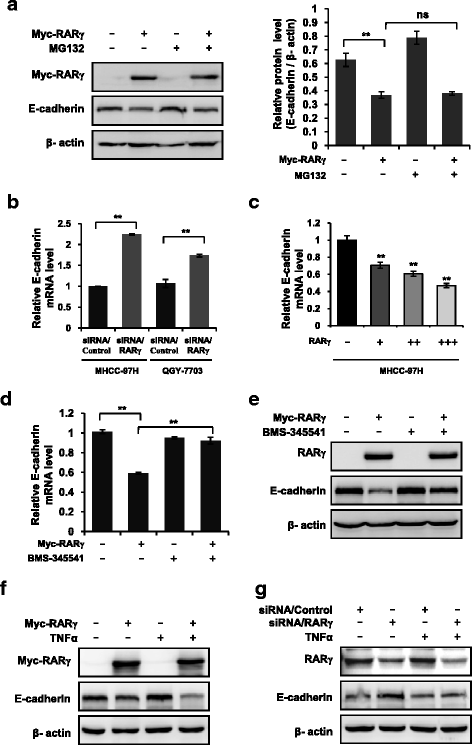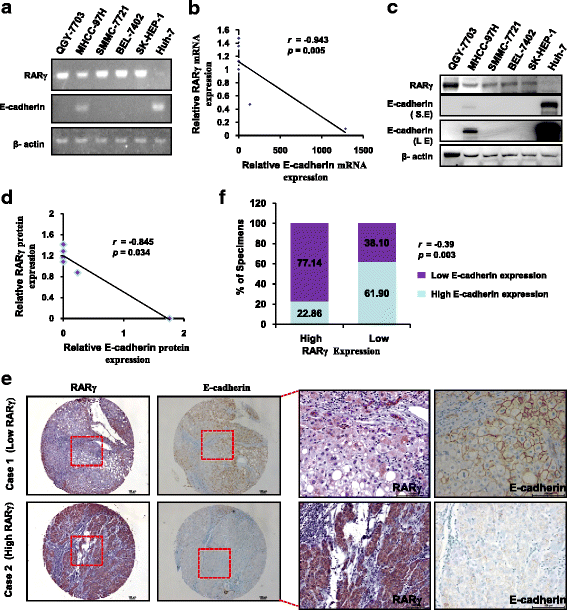RARγ-induced E-cadherin downregulation promotes hepatocellular carcinoma invasion and metastasis
- PMID: 27756432
- PMCID: PMC5069892
- DOI: 10.1186/s13046-016-0441-9
RARγ-induced E-cadherin downregulation promotes hepatocellular carcinoma invasion and metastasis
Abstract
Background: Aberrant expression of Retinoic acid receptor γ (RARγ) is implicated in cancer development. Our previous study identified that RARγ functions as a tumor promoter to drive hepatocellular carcinoma (HCC) growth. However, its contribution to HCC invasion and metastasis remains unclear.
Methods: RARγ expression in clinical HCC samples was detected by western blot and immunohistochemistry. The relationship between RARγ expression levels and the clinical characteristics were evaluated. HCC cell line MHCC-97H were stably knocked down RARγ using a lentivirus vector-based shRNA technique. The cells were analyzed by migration and invasion assays, and injected into nude mice to assess tumor metastasis. E-cadherin expression regulated by RARγ was examined by qPCR, western blot and immunofluorescence staining.
Results: The expression of RARγ is significantly upregulated in human HCC tissues. Moreover, its expression positively correlates with tumor size, distant metastasis and TNM stage, and negatively correlates with length of survival of HCC patients. Knockdown of RARγ markedly inhibits HCC cell invasion and metastasis both in vitro and in vivo. Mechanistic investigations reveal that RARγ functions through regulation of NF-κB-mediated E-cadherin downregulation to promote HCC invasion and metastasis. Notably, RARγ expression status negatively correlates with E-cadherin expression in HCC cell lines and clinical HCC samples.
Conclusions: These findings demonstrate that RARγ could promote HCC invasion and metastasis by regulating E-cadherin reduction, and implicate new strategies to aggressively treat HCC through targeting RARγ/E-cadherin signaling axis.
Keywords: E-cadherin; Hepatocellular carcinoma; Metastasis; RARγ.
Figures





Similar articles
-
MTBP Promotes the Invasion and Metastasis of Hepatocellular Carcinoma by Enhancing the MDM2-Mediated Degradation of E-Cadherin.Dig Dis Sci. 2015 Dec;60(12):3681-90. doi: 10.1007/s10620-015-3824-4. Epub 2015 Aug 18. Dig Dis Sci. 2015. PMID: 26280083
-
TRIM52 up-regulation in hepatocellular carcinoma cells promotes proliferation, migration and invasion through the ubiquitination of PPM1A.J Exp Clin Cancer Res. 2018 Jun 13;37(1):116. doi: 10.1186/s13046-018-0780-9. J Exp Clin Cancer Res. 2018. PMID: 29898761 Free PMC article.
-
FoxM1 overexpression promotes epithelial-mesenchymal transition and metastasis of hepatocellular carcinoma.World J Gastroenterol. 2015 Jan 7;21(1):196-213. doi: 10.3748/wjg.v21.i1.196. World J Gastroenterol. 2015. PMID: 25574092 Free PMC article.
-
The Emerging Oncogenic Role of RARγ: From Stem Cell Regulation to a Potential Cancer Therapy.Int J Mol Sci. 2025 May 3;26(9):4357. doi: 10.3390/ijms26094357. Int J Mol Sci. 2025. PMID: 40362593 Free PMC article. Review.
-
Expression and role of icam-1 in the occurrence and development of hepatocellular carcinoma.Asian Pac J Cancer Prev. 2013;14(3):1579-83. doi: 10.7314/apjcp.2013.14.3.1579. Asian Pac J Cancer Prev. 2013. PMID: 23679239 Review.
Cited by
-
The Crosstalk Between Cancer Cells and Neutrophils Enhances Hepatocellular Carcinoma Metastasis via Neutrophil Extracellular Traps-Associated Cathepsin G Component: A Potential Therapeutic Target.J Hepatocell Carcinoma. 2021 May 20;8:451-465. doi: 10.2147/JHC.S303588. eCollection 2021. J Hepatocell Carcinoma. 2021. PMID: 34046369 Free PMC article.
-
Epigenetic modification of hepatitis B virus infection and related hepatocellular carcinoma.Virulence. 2024 Dec;15(1):2421231. doi: 10.1080/21505594.2024.2421231. Epub 2024 Nov 20. Virulence. 2024. PMID: 39460469 Free PMC article. Review.
-
Sortilin 1 Promotes Hepatocellular Carcinoma Cell Proliferation and Migration by Regulating Immune Cell Infiltration.J Oncol. 2022 Jul 8;2022:6509028. doi: 10.1155/2022/6509028. eCollection 2022. J Oncol. 2022. PMID: 35847356 Free PMC article.
-
Krüppel-like factor 9 upregulates E-cadherin transcription and represses breast cancer invasion and metastasis.Am J Cancer Res. 2021 Jul 15;11(7):3660-3673. eCollection 2021. Am J Cancer Res. 2021. PMID: 34354866 Free PMC article.
-
KLF4-Mediated CDH3 Upregulation Suppresses Human Hepatoma Cell Growth and Migration via GSK-3β Signaling.Int J Biol Sci. 2019 Mar 10;15(5):953-961. doi: 10.7150/ijbs.30857. eCollection 2019. Int J Biol Sci. 2019. PMID: 31182916 Free PMC article.
References
-
- Yeo W, Mok TS, Zee B, Leung TW, Lai PB, Lau WY, Koh J, Mo FK, Yu SC, Chan AT, et al. A randomized phase III study of doxorubicin versus cisplatin/interferon alpha-2b/doxorubicin/fluorouracil (PIAF) combination chemotherapy for unresectable hepatocellular carcinoma. J Natl Cancer Inst. 2005;97(20):1532–1538. doi: 10.1093/jnci/dji315. - DOI - PubMed
-
- Du ZG, Wei YG, Chen KF, Li B. Risk factors associated with early and late recurrence after curative resection of hepatocellular carcinoma: a single institution's experience with 398 consecutive patients. Hepatobiliary Pancreat Dis Int. 2014;13(2):153–161. doi: 10.1016/S1499-3872(14)60025-4. - DOI - PubMed
MeSH terms
Substances
LinkOut - more resources
Full Text Sources
Other Literature Sources
Medical
Miscellaneous

